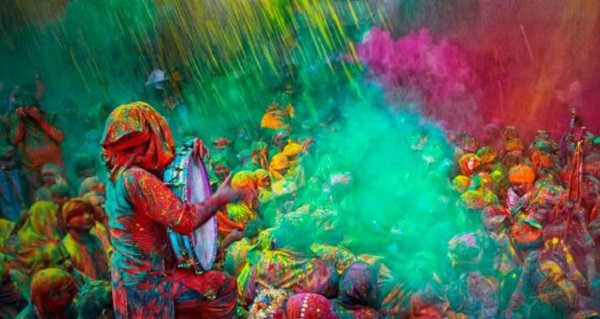MYTHOLOGICAL ORIGINS AND ACTIVITIES OF THE HINDU HOLI FESTIVAL. Hindus around the world celebrate the arrival of spring in a very colorful way. It’s literally colorful since the primary activity involves the splashing of both powder dyes and colored water on one another. The celebration is called Holi or Phagwa and is celebrated on the last full moon of the Hindu month Phalguna. It usually falls between late February until March and this year, it will be celebrated on March 23. Happy Holi! The Hindu Festival of Colors TWEET THIS Because it is associated with the spring season, Holi is considered to be the least religious festivity in Hindu tradition. It’s a celebration of the shift from winter to the spring and cropping season, the various colors of the season, of thanksgiving, a festival of sharing love, forgiving and forgetting, meeting people and building relationships, starting out a fresh year and including the forgiveness of debt. It’s also the time of the year when nothing else is regarded aside from merrymaking. Conservative social norms and behaviors can be loosened to accommodate the uniquely fun, wild and ribald behavior during this special time. There is a common saying heard during Holi is bura na mano, Holi hai (“don’t feel offended, it’s Holi”). It is mainly celebrated in Nepal and India where much of the population is Hindu, although it has spread to other areas such as Europe and North America too.
MYTHOLOGICAL ORIGINS OF THE HOLI FESTIVAL There are three Hindu stories that explain the roots of this festivity. First is the tale about the demon king Hiranyakashipu and his sister Holika where the term “Holi” was believed to be derived. The demon king became so arrogant because he believed he is powerful, indestructible and eventually acted as a god. He ordered his followers not to worship any deity except for him. But his son Prahlada disobeyed and remained faithful in worshipping Lord Vishnu.
As a punishment and to test his son’s faith, Hiranyakashipu ordered that Prahlada and Holika sit on raging fire. Holika was believed to be immune from fire because of her magical cloak. But as the fire roared, the cloak miraculously flew towards Prahlada saving him while his aunt Holika was burned. The demon king became more infuriated and Lord Vishnu suddenly appeared and killed him. After the fire, people gathered to collect the ashes and applied it to their foreheads. The bonfire that killed Holika eventually symbolized the victory of good versus evil.
The second story is about Krishna and his love Radha. Based on the legend, Lord Krishna fell in love with Radha but became hesitant because of his dark blue skin color. To boost the confidence of Krishna, his mother Yashoda advised him to color Radha’s face with any color he wanted. Krishna did and they eventually became a couple. This playful coloring of the face has been the explanation of today’s Holi tradition. The third story is about Madana’s (god of love) efforts to test Lord Shiva’s deep concentration. Lord Shiva is celebrated for his meditative nature and he spent many of his hours in Meditation. Madana went to visit Shiva in form of a beautiful nymph but Shiva was able to recognize Madana. Shiva became furious and he shot fire from his third eye and burned Madana to ashes. The Holi bonfire is used to symbolize this mythology.
ACTIVITIES DURING THE FESTIVAL No matter where there location is, Hindus around the world celebrate Holi in a similar manner. The two notable activities include the Holika bonfire and the festival of color. In most parts of India, the festivity is held for two days while there are some who extend it up to two weeks. The Holika bonfire is done on the first night of the festivity. But even days before it, people in communities gather wood to be able to create a large and lasting bonfire. The next day is the highlight of the festivity. People get out on the streets with their own powder colors or colored water. In a playful manner, these colors are dashed, sprayed and even splashed to everyone. Though splashing of colors is free on the streets, home, office and temple interiors are usually left untouched. After cleaning up, people feast on a myriad of sweets, delicacies and drinks. In certain regions, singing, dancing and band playing is part of the merrymaking.
Widows are typically forbidden from celebrating Holi because they’re not permitted to join in religious celebrations. The past few years have seen widows breaking this tradition by replacing their typical white saris with colorful ones and joining in on the colorful day.
Source: http://www.worldreligionnews.com/religion-news/hinduism/happy-holi-the-hindu-festival-of-colors






